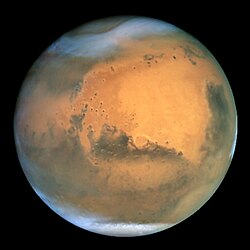Baldet (Marskrater)
- För andra betydelser, se Baldet.
| Marskrater | |
|---|---|
| Baldet | |
 | |
| Egenskaper | |
| Koordinater | 22.76˚ N, 65.48˚ Ö |
| Medeldiameter | 181.31 km |
| Uppkallad efter | Henri Baldet |
| Mars - ( ) | |
Baldet är en krater på planeten Mars namngiven efter den franske astronomen Fernand Baldet.
Kratern har en diameter på ungefär 181 km.
Se även
Källor
- ”Baldet on Mars” (på engelska). International Astronomical Union. 17 november 2010. https://planetarynames.wr.usgs.gov/Feature/575. Läst 17 februari 2024.
| ||||||||||||||||||||||||||||||||||||||||||||||||||||||||
Media som används på denna webbplats
NASA's Hubble Space Telescope took the picture of Mars on June 26, 2001, when Mars was approximately 68 million kilometers (43 million miles) from Earth — the closest Mars has ever been to Earth since 1988. Hubble can see details as small as 16 kilometers (10 miles) across. The colors have been carefully balanced to give a realistic view of Mars' hues as they might appear through a telescope. Especially striking is the large amount of seasonal dust storm activity seen in this image. One large storm system is churning high above the northern polar cap (top of image), and a smaller dust storm cloud can be seen nearby. Another large dust storm is spilling out of the giant Hellas impact basin in the Southern Hemisphere (lower right).
Mars digital-image mosaic merged with color of the MC-13 quadrangle, Syrtis Major region of Mars. The central part is dominated by dark dust and lava flows of the Syrtis Major Planitia region. These lava flows are partly bounded to the east by a large depression, Isidis basin, which contains smooth plains, and to the west and north by heavily cratered and moderately faulted highlands. Latitude range 0 to 30 degrees, longitude range -90 to -45 degrees.


